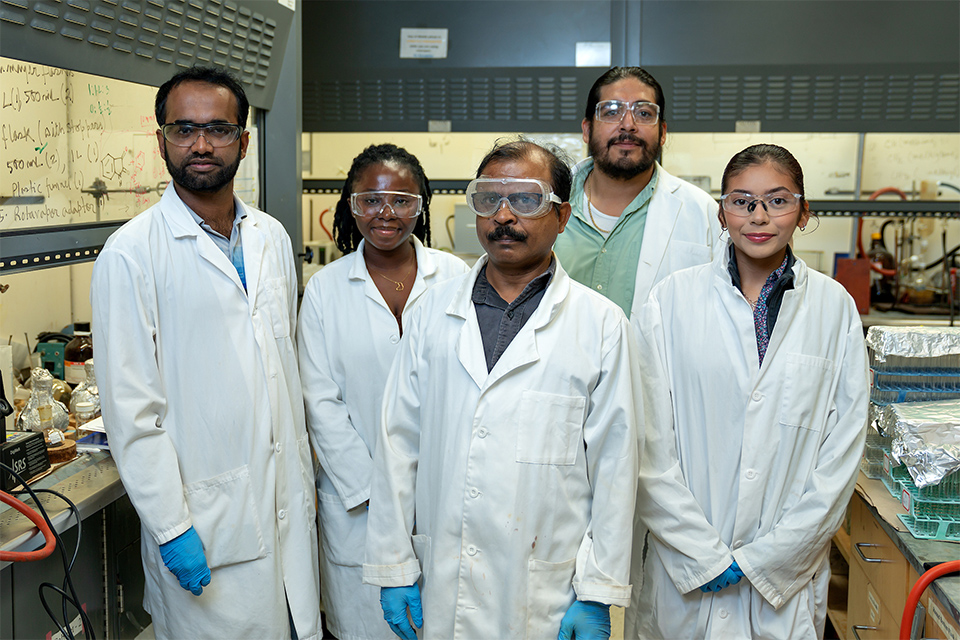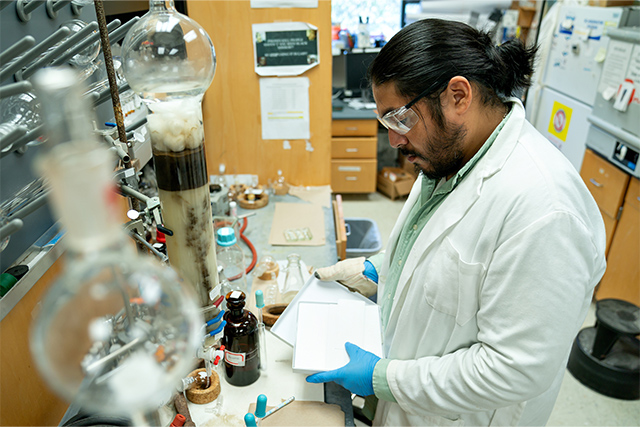By Amanda A. Taylor-Uchoa
RIO GRANDE VALLEY, TEXAS – FEB. 24, 2025 – Researchers at The University of Texas Rio Grande Valley have discovered a groundbreaking use for aloe vera peels, transforming this discarded agricultural waste into a natural insecticide that could benefit farmers worldwide.
Dr. Debasish Bandyopadhyay, an associate professor in the UTRGV School of Integrative Biological and Chemical Sciences and the project's principal investigator, became intrigued by the potential of aloe vera rinds during a visit to a local production facility. He noticed that insects avoided the aloe plants while attacking neighboring vegetation, leading him to explore the possibility of repurposing the peels, which are typically thrown away or minimally used to enhance soil quality.
“Millions of tons of aloe peels are likely disposed of globally every year,” Bandyopadhyay said. “We wanted to find a way to add value and make them useful.”
FROM WASTE TO WORTH
Aloe vera, scientifically known as Aloe barbadensis, has been used for millennia to treat skin ailments, promote digestive health and heal wounds. While the gel inside the leaves is highly valued, the outer peels have been largely overlooked – until now.
The research team identified more than 20 bioactive compounds in the aloe vera rinds using high-performance liquid chromatography coupled with tandem-mass spectrometry. Among these were six compounds recognized for their insecticidal properties, including octacosanol, subenniatin B, dinoterb, arjungenin, nonadecanone and quillaic acid.
“These compounds could be the key to developing a natural insecticide that is both effective and environmentally friendly,” Bandyopadhyay said. “By recycling the peels, we're not only reducing waste but also providing farmers with a sustainable pest control alternative.”
This innovative research is supported by the UTRGV Faculty SEED Grant and the U.S. Department of Agriculture's National Institute of Food and Agriculture.
GRADUATE STUDENTS CONTRIBUTE TO GROUNDBREAKING RESEARCH
Jakir Hossain, a graduate student in the Department of Chemistry working under Bandyopadhyay, played a significant role in the research.
“In our lab, we focus on both natural product chemistry and synthetic chemistry,” Hossain said. “For my thesis, I'm working on natural product chemistry.”
Discussing the significance of the aloe vera research, Hossain explained: “While aloe vera gel is widely used for medicinal purposes, the rinds are not utilized and often discarded. We discovered that these rinds have insecticidal properties. Our goal was to identify which compounds are responsible for this activity.”
Hossain noted the process is meticulous but necessary.
“We separated the aloe vera rinds and dried them away from sunlight to prevent any unwanted reactions,” he said. “Once dried, they became crusty, and we ground them into a powder. We then performed bioactivity-guided extraction sequentially using solvents like dichloromethane, methanol, and water.”
Hossain emphasized the importance of their polarity-guided extraction methods.
“Using a range of solvents with different polarities allowed us to isolate compounds effectively,” he said. “This step-by-step approach helped us separate and identify the bioactive compounds.”
To expedite purification, the team employed advanced techniques.
“We used flash chromatography, which provides quick separation in minimal time,” Hossain said. “While traditional column chromatography could take over a month, flash chromatography allowed us to achieve results within a couple of hours, although the process needs to be repeated several times to isolate a good amount of pure compounds.”
ADVANCEMENTS IN GREEN CHEMISTRY
Graduate student Esther Owusu, focusing on synthetic chemistry side of the research, highlighted the importance of green chemistry in their work.
“What I'm doing is green chemistry,” Owusu said. “I use water as a solvent for my reactions, so I don't use any chemicals that can cause harm. It's very easy, very clean and the byproducts are not harmful to the environment.”
Owusu explained how she employs controlled microwave-assisted synthesis to speed up reactions.
“I combine different chemicals and use the microwave to facilitate the reactions,” she said. “The purpose of the microwave is to help us speed up the reaction so we can get results earlier. In previous years, reactions could take days or even months. Now, using the microwave, some reactions take just a few minutes or even seconds.”
She added that the microwave used is specifically designed for chemical reactions and operates in a safe, closed system, ensuring no harm to her colleagues nearby.
UNDERGRADUATE STUDENTS ENHANCE RESEARCH EFFORTS
Undergraduate student Lauren Sanchez, a senior majoring in biological sciences, is also part of Bandyopadhyay’s research team.
“As a STEM student, I think that it is very important to learn these new research methods that we learn here in the lab,” Sanchez said. “It gives me an opportunity to learn and obtain new experiences.”
Sanchez is currently working on synthesizing an anticancer beta-lactam compound. Although her project is separate from the aloe vera research, she appreciates the collaborative environment.
“We’re working with aloe vera and the beta-lactam compounds, and I think that's very important for figuring out methods and understanding how to work with them,” she said.
Undergraduate student Alfredo Landeros, a chemistry major at UTRGV, also made significant contributions to the research.
“We deal with natural products here,” Landeros said. “Throughout history, humans have always used natural remedies for medicine. We're able to find out what compounds were used in the past and bring it down to real science, which is what we're doing here. I think it's really great.”
GLOBAL RECOGNITION AND IMPACT
The significance of this research has not gone unnoticed. Out of approximately 12,000 presentations accepted for the American Chemical Society's Fall 2023 national meeting in San Francisco, Bandyopadhyay's presentation was selected for a press release, highlighting its groundbreaking nature.
Additionally, the research has received extensive international media coverage, with 214 news outlets worldwide featuring the story in multiple languages.
“The global interest in our work underscores the universal importance of sustainable agricultural practices,” Bandyopadhyay noted.
The potential applications of this discovery are far-reaching. In regions where insects threaten crops – such as parts of Africa, the tropical and subtropical Americas and the maize and millet fields of India – this natural insecticide could offer a cost-effective and eco-friendly solution.
“Our goal is to recycle this agricultural waste in a meaningful way while making aloe production greener and more sustainable,” Bandyopadhyay said.
Beyond agricultural use, the team is exploring the development of consumer products to combat mosquitoes and ticks.
“If the peels show good anti-mosquito or anti-tick activity, we can also help the general public,” he added.
ABOUT UTRGV
The University of Texas Rio Grande Valley (UTRGV) was created by the Texas Legislature in 2013 as the first major public university of the 21st century in Texas. This transformative initiative provided the opportunity to expand educational opportunities in the Rio Grande Valley, including a new School of Medicine and a School of Podiatry, and made it possible for residents of the region to benefit from the Permanent University Fund – a public endowment contributing support to the University of Texas System and other institutions.
UTRGV has campuses and off-campus research and teaching sites throughout the Rio Grande Valley including Brownsville (formerly The University of Texas at Brownsville campus), Edinburg (formerly The University of Texas-Pan American campus), Harlingen, Weslaco, McAllen, Port Isabel, Rio Grande City and South Padre Island. UTRGV, a comprehensive academic institution, enrolled its first class in the fall of 2015; the School of Medicine welcomed its first class in the summer of 2016, and the School of Podiatric Medicine in the fall of 2022.




